Undoubtedly, Peru is one of the American countries with the most tourist attractions. Because its mysteries and ancient history. Among its numerous archaeological sites, there is an ancient place considered the largest mud city in the world. We refer to Chan Chan.
This ancient mud city is close to Trujillo, an essential Peruvian city north of Lima. Specialists consider the city’s structure and the knowledge of its architecture highly advanced for the XV century. Thus, with the help of the travel experts at Machu Travel Peru, we want to tell you everything about this ancient complex. In this short article, we will examine this incredible place and its main characteristics.
Everything you need to know about the ancient and largest mud city worldwide
- Chan Chan
- The Chimu Kingdom
- History
- Architecture
- Deterioration
- How to get there
- Best time to visit it
- Entrances and Schedules
- A tour guide for Chan Chan
- What to bring
Chan Chan
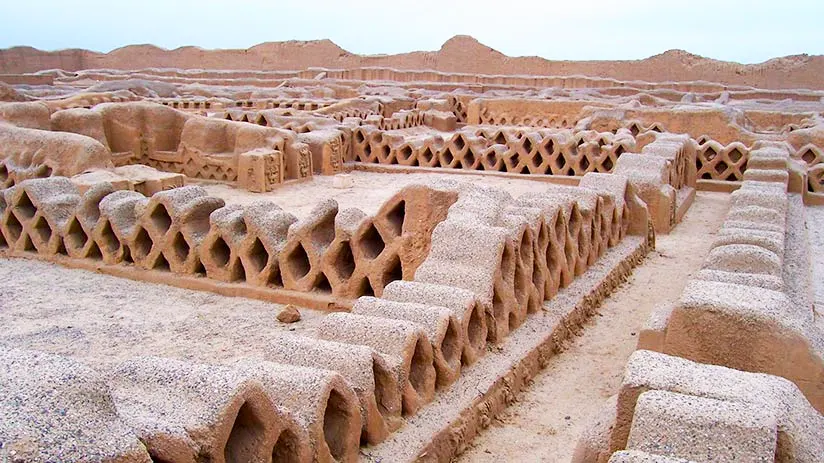
Scholars know this city as the largest city of mud in the world and its inhabitants as the Chimu culture. This civilization flourished between 1200 B.C. and 1465 B.C. and is more than 700 years old. 10,000 well-decorated buildings with beautiful walls formed the adobe city. Also, specialists estimated that 30,000 to 60,000 residents lived there.
Also, there were numerous gardens and green areas because its advanced irrigation systems. Therefore, current experts consider its construction techniques and knowledge of irrigation channels advanced for the XV century. For this reason, UNESCO declared it a World Heritage Site in 1986. Today, everyone can appreciate part of its beauty.
A. Chan Chan location
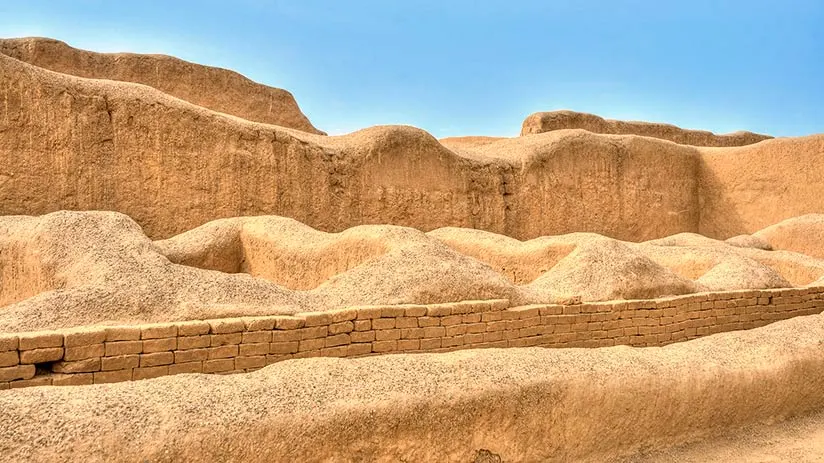
The large mud city is 5 kilometers west of Trujillo, an essential northern coast Peruvian city. Trujillo is 557 kilometers from Lima, the capital of Peru. It is on a desert strip between the Pacific Ocean and the Mountain Range. As you can see, getting there is usually not a major problem.
The entire complex covers approximately 20 square kilometers of desert land and mud. So, visit this fantastic mud city and enjoy authentic tourism in Peru.
The Chimu kingdom
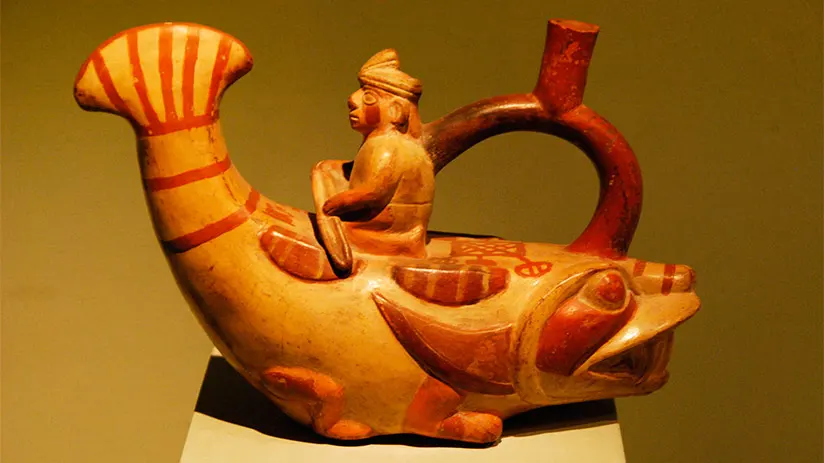
The Chimu kingdom was one of the pre-Columbian civilizations that reached its peak during the 15th century. As descendants of the extinct Mochica culture (150 – 700 A.D.), they founded their mud capital on the north coast of Peru.
Around 1400 A.D, Minchanzaman, was the main regent. He extended the territory up to Piura in the north and up to Paramonga in the southbound. For two centuries, it was the central state of the north of Peru, and today one of the most famous places in Peru. Their great expansion occurred thanks to their economic activities, their successful military campaigns, and their policies of demanding tributes.
Because of its underground aqueducts, which brought drinking water to the city, they had agriculture and irrigation. Scholars even consider this technology highly advanced for the 15th century in South America. Also, fishing and goldsmiths were their main economic activities.
The different vestiges and remains of the city reflect clear and strict political and social strategies.
In this sense, you have this hierarchical, well-defined system of social classes.
- The Chimuc Capac was the sovereign of everything.
- The Curacas (chief) were nobles and owners of lands, besides managers of subject peoples.
- The middle-upper-class people were assistants to the Curacas (chief), and they had certain privileges. For example, they benefited directly from the harvest of the land.
- The artisans were farmers but with a greater social range. They produced delicate fabrics and objects of gold, silver, and copper. In addition, they made up numerous ceramic works with standardized designs and in molds.
- The farmers were the workforce of the empire. Fishing, agriculture, crafts, and trade are their main activities.
- Finally, the servants dedicated their lives to serving Chimuc Capac and the Curacas.
1. The Quingnam language
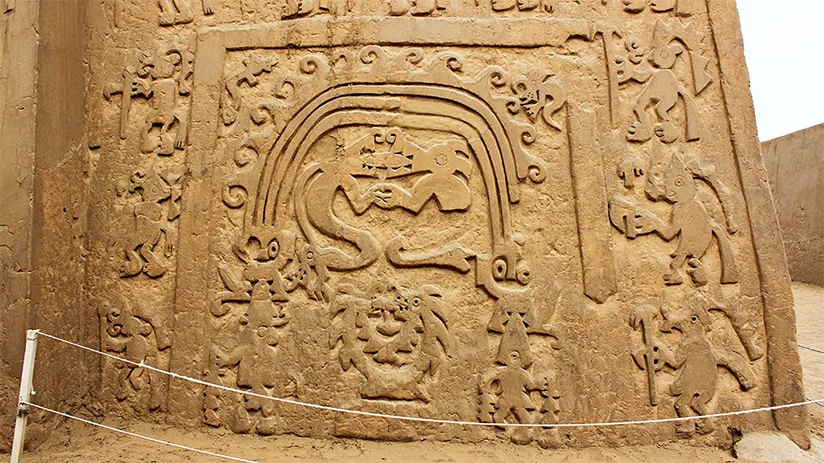
The Chimú spoke Quingnam, a fascinating now-extinct language. The language of a predecessor culture called Mochica gave rise to this idiom. The Quingnam was fascinating due to its sound; so guttural and a bit scary.
This description came to us thanks to the writings of the Calancha priest. He was an ancient Spanish chronicler who studied the zone in 1653. Precisely, Chan Chan means “The City of the Sun” in the Quingnam language.
Unfortunately, Quangnam disappeared once the Spanish conquered the Incas. They razed the great city of mud in search of gold and silver.
History
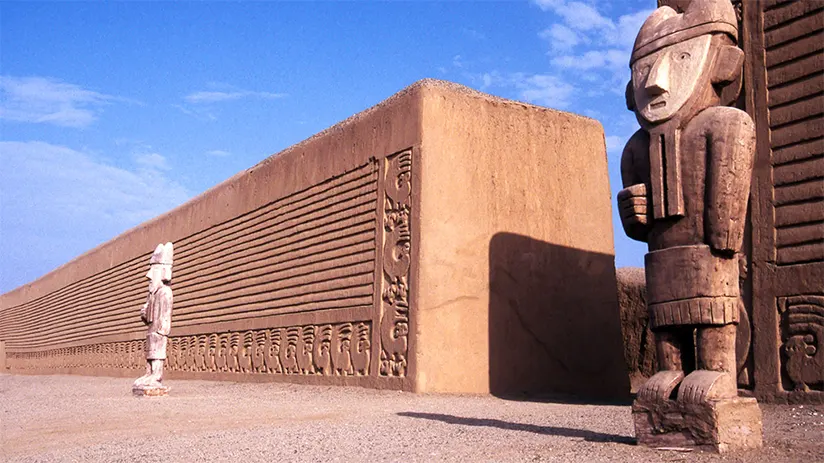
This mud city was the ancient capital of the Chimú kingdom. Its construction lasted between the twelfth and thirteenth centuries of the Christian era. The entire city consisted of numerous streets, walls, buildings, pyramid temples, and other important palaces. The long construction time was worth it.
The different structures shaped the different “neighborhoods” inserted in 10 “walled-citadels.” For this reason, many studies affirm the significant development of the entire civilization of the Chimus for their time. Despite the Inca’s conquest, the Chimu people kept their great city, even their costumes, traditions, and gods.
However, with the arrival of the Spanish, the city could fall into oblivion. This truth constitutes one of the most important facts about Peru and the beginning of the Chimu culture debacle.
1. An encounter with the Incas
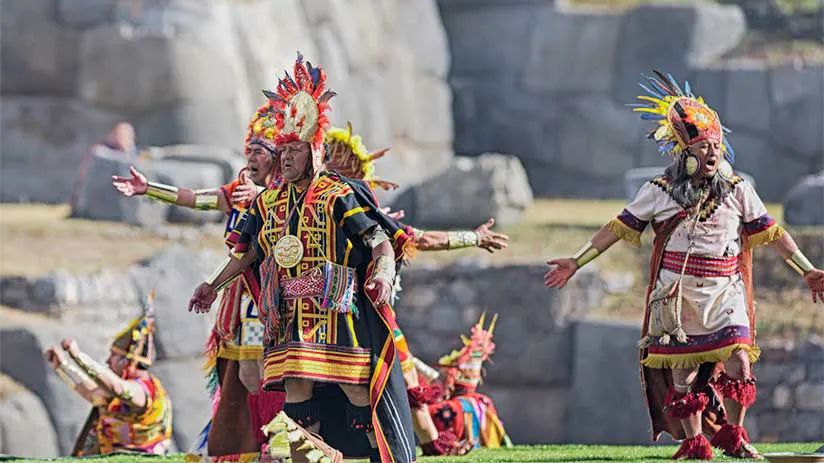
Between 1465 and 1470, the Chimu fell under Inca rule. It was in 1470 when Tupac Yupanqui completely besieged the city, cutting off their water supplies and canals. In this form, the Andean left northern civilization completely cut off. So, the population surrendered immediately.
However, the majority of them chose to continue inhabiting the area with the permission of the Incas. Except for the Chimu craftsmen, the Incas moved the rest of the Chimu population to Cusco to work under the orders of the Inca. The scholars affirm that the Inca’s conquest reduced the Chimu population to 10,000 inhabitants.
Some thirty years later, the Chimú decided to rise against the Incas, but their effort was in vain. The Huayna Capac army put down the rebellion. And ordered the great mud-city to remain vacant, causing minor damage. However, the rebellion was one of the endpoints of the Chimú culture.
When the Spanish arrived, they looted the city completely. They searched for a variety of treasures, looting numerous valuables such as gems, gold, silver, and much more. After the conquest, the Spanish writers recorded a few Chimu historical and mythological traditions. However, these documents were insufficient to understand this great culture.
Today, Chimu’s magnificence and beauty persist. It is a must-see for those seeking to learn about the ancient history of America.
Architecture
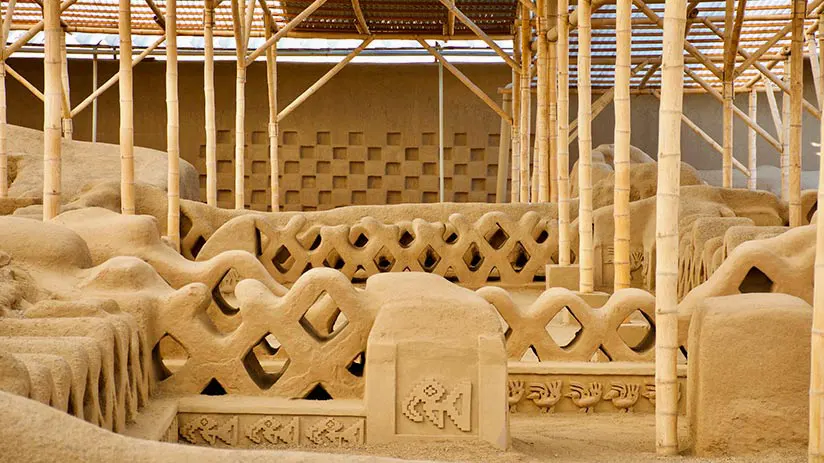
The way how Chan Chan was planned hierarchically is why this large mud city can be considered one of the most amazing archaeological treasures in Peru. The Chimus included industrial, agricultural, and fluvial systems in the design of its mud city. This city was very advanced at the time of construction.
Therefore, the tremendous monumental area in the center of the city was undoubtedly previously larger. Around 20 square kilometers. High walls well-decorated with geometric forms, animals, and sea life figures protected most of the complex.
Many of them also protected the 10 citadels located inside the monumental area. Some of these walls still stand and reach a height of up to 15 meters (50 feet) and have a single access. Thus facilitating the control of who entered each citadel and the same monumental area.
A. 10 neighborhoods
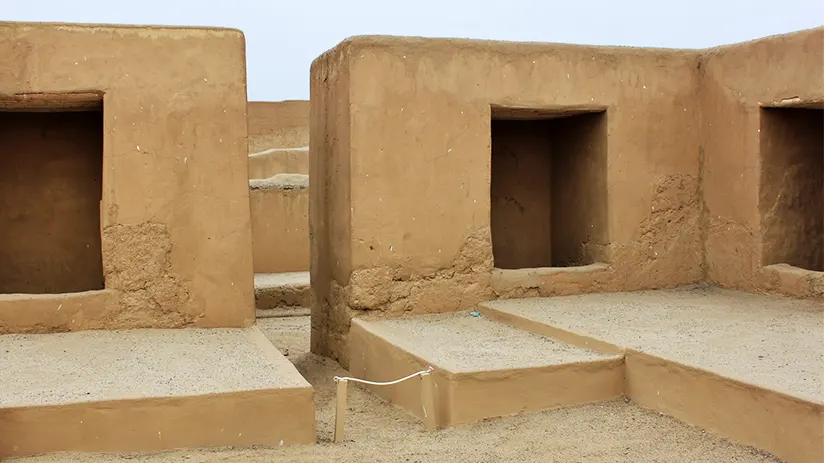
These 10 citadels also had labyrinthine interiors. In addition, the Chimus grouped them into three major sectors. The northern sector used to be a plaza that led to certain citadels (warehouses or audiences).
On the other hand, most of the other buildings were in the Central sector. The archaeologists found vestiges of kitchens and bedrooms in the South sector. Happily, many of these last ones still stand. It seems that each ruler, together with his entourage, managed each complex (citadel).
Moreover, around these 10 citadels, there were about 30 enclosures that resembled sovereign palaces. These had their water wells, patios, and reservoirs. The specialists even affirm that the lower-ranking nobles or Curacas lived in these surrounding spaces.
Instead, the highest-ranking rulers and nobles settled in the center of the city or in the monumental area. Without mentioning that this was the main setting for various celebrations, rituals, and activities.
B. Walls
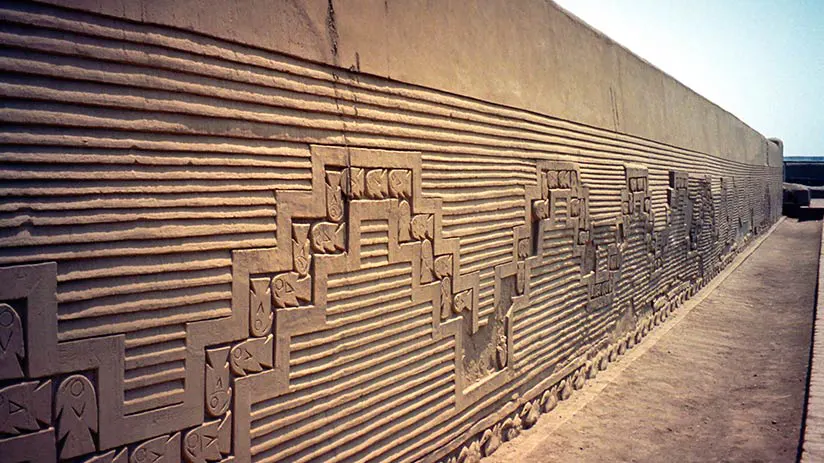
You will see ancestral enclosures during a guided tour through the different palaces. There, beautiful tiles with high-relief decorations cover their murals. On the different walls, you will be able to see large representations of fish both on the left and on the right, too.
This iconography represents the two currents that distinguish the Peruvian coast. Both the Humboldt current in the south (cold water) and the El Niño current that comes from the north (hot water). You can also see wave designs, fishing nets, and pelicans.
C. What else to see
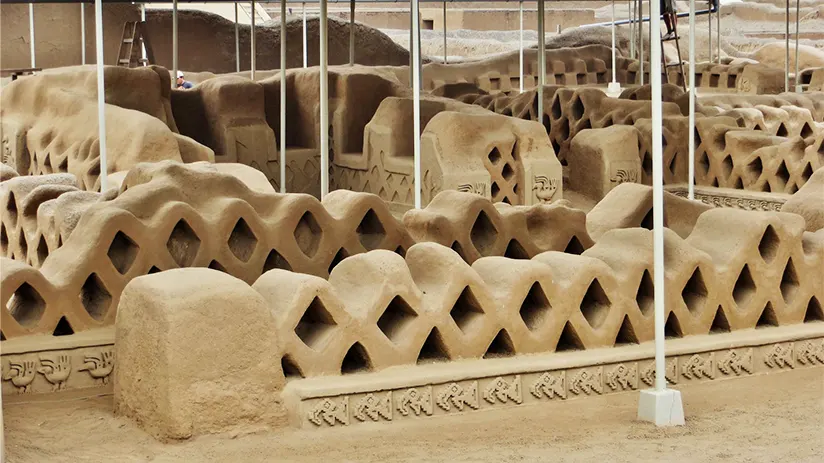
When you enter the complex for the first time, you will find the following areas.
a. Nik An Palace
It is the first area where you will find souvenir stands, bathrooms, and ticket offices. Also, many tour guides are prowling the area. In addition, the Nik An Palace is the only one covered by tent-like structures and is completely refurbished. In other words, it is the visitor’s first impression of what Chan Chan was like.
b. Main Plaza
Following the route, you’ll find an awesome large plaza where, once in a time, the Chimu king gave commands to his subjects. The plaza is rectangular with solid walls 4 meters thick on each side, and geometric designs decorated them. There are designs of three or four sea otters on the inferior level of a wall, very close to the entrance. These are the only originals from all over the area.
c. Audience rooms
Exit the Main Plaza and walk down a passageway. Undulating fish and birds decorate its side walls. Finally, you’ll reach the Audience Rooms. These are intricate rooms whose access passage resembles a maze.
These must have been very important since they are many and well-decorated. Figures of fish, waves, marine birds, and mammals decorate their walls. Don’t forget that the Chimus worshiped the moon, sea, and the animals that came from it.
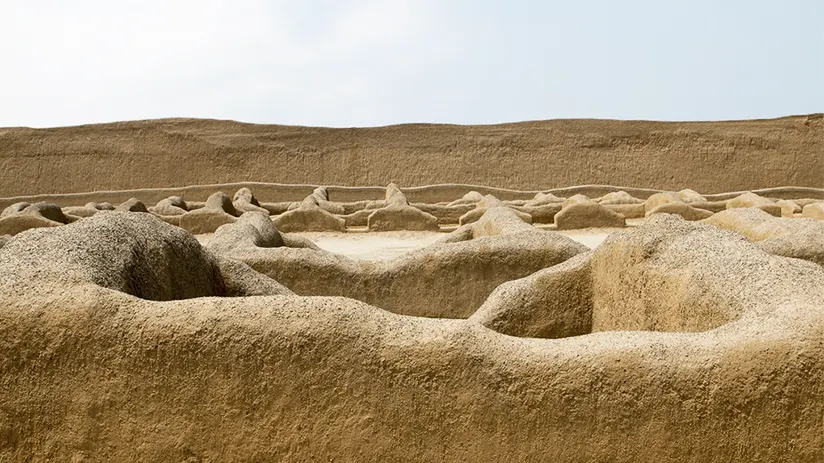
d. Gran Hachaque Ceremonial
It is a beautiful freshwater pool where the Chimus priests developed some ceremonial rituals. A green border of reeds and grasses surrounds it. Recent studies affirm that channels of more than 50 miles of extension connected the Moche River with the pool and fed it.
e. Warehouses
There are small rooms, very close to each other, on the left of the Great Hachaque Ceremonial. Some studies affirm that these could have been warehouses for food. Other investigations say that these could have been cells for the rest of the soldiers.
f. The Mausoleum
This is a great king’s burial chamber. Many ceremonial objects and bodies of his servants accompany the chamber. However, the most impressive thing is the pyramid containing dozens of human sacrifices of young maidens. They sacrificed her to take advantage of the king’s burial.
g. Assembly room
It is a rectangular saloon with 24 niches well-carved in each wall of the enclosure. Each niche hosted a seat. Once seated, the occupant could speak in half a tone and be heard perfectly. It was because of the perfect acoustics of the place.
Deterioration
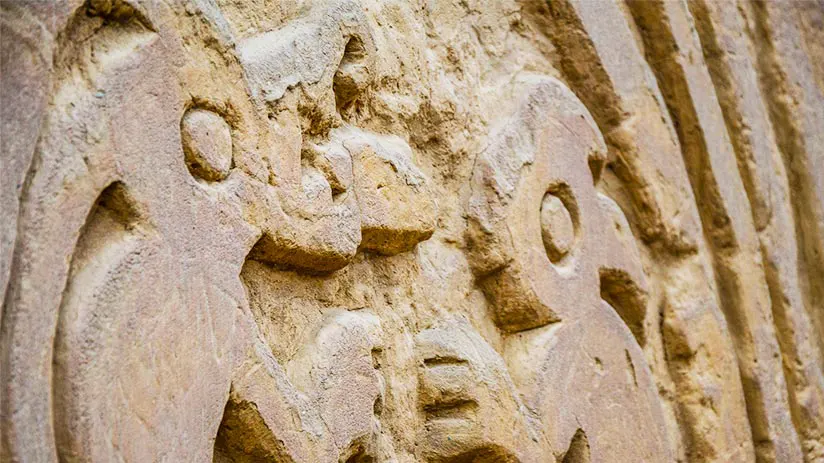
After the looting carried out by the Spanish in 1532, not much of the great Chimu culture remained, including Chan Chan. Even much of the old and true city had already disappeared in colonial times. In addition, the mud city melts slowly due to increasing climate change and its high humidity. Another threat is the growing intensity of the El Niño weather phenomenon, which produces torrential rains.
Moreover, the strong saline winds from the Pacific Ocean damage structures of land and mud. For this reason, erosion continues to jeopardize these construction marvels. Nowadays, local archaeologists and personnel have covered the majority of temples, enclosures, and walls with temporary pre-fabricated roofs.
This is to protect them from rain, wind, and humid sea breezes. For this reason, this mud city has to be on your list of the best things to do In Peru as soon as possible. To visit it, paying your ticket entrance contributes to its conservation and facing these natural threats.
How to get there
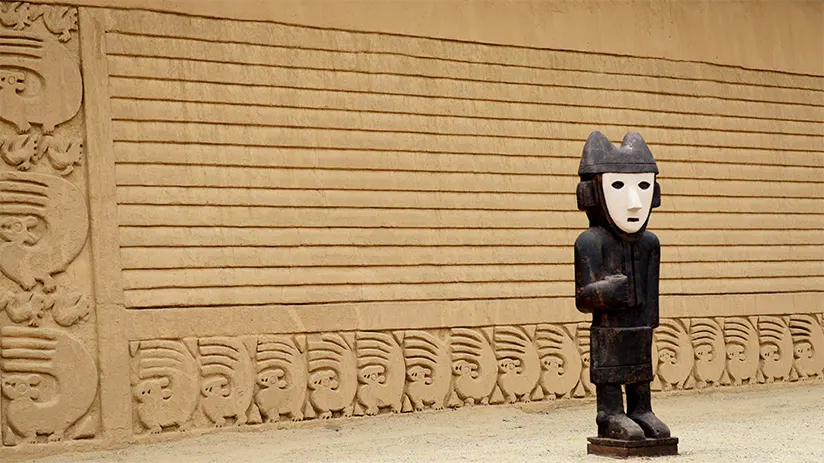
If you are in Lima, the entrance door of any visitor to Peru. The international airport and the marine port of Callao are there. Also, you can get to Trujillo on a short trip by plane, bus, or private car.
1. From Lima to Trujillo by bus, airplane, or private car
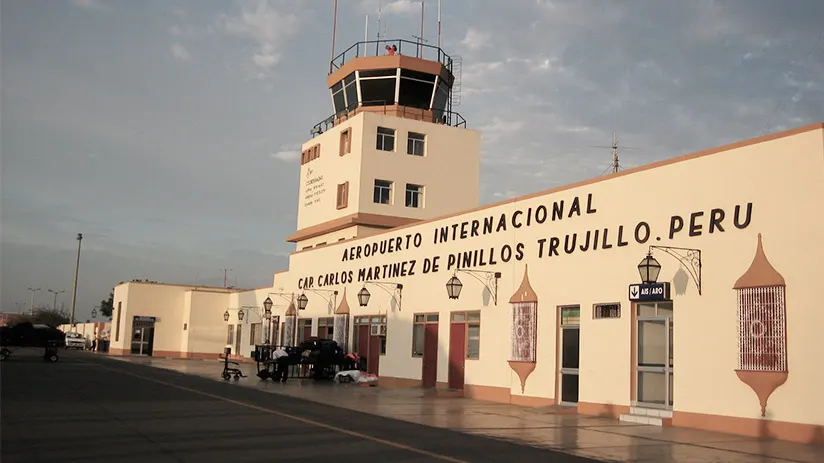
From Lima to Trujillo, there are about 560 kilometers or 350 miles. You can enjoy the landscapes traveling by bus depending on your available time. Each bus company has its own terminal in Lima.
Buses depart every day for Trujillo. The cost of a bus ticket is around $22 one way, and you can buy them online. The trip lasts 8 to 10 hours. Cruz del Sur, Movil Tours, and Civa are the most popular bus companies.
Or simply save time and take a flight. In the same way, the flight frequency between Lima and Trujillo and vice versa is diary. A flight ticket costs around $55 – $65 (one way), and you can buy them online. The flight lasts around 35 minutes. The most well-known flight companies are LATAM, Sky Airlines, and Jet Smart.
If you hire a private car to get to Trujillo, you can travel at your own pace following the Pan-American highway. This highway runs parallel along all South American coasts since Lima and Trujillo are on the Peruvian coast.
The car trip lasts around 08 – 10 hours. However, car rental is not cheap; you can spend around $100 to $120 per day. Not to mention the guaranteed amount that you have to pay in advance, which is around $500.
Of course, this amount is refunded at the finish of the rent, with the car in the same condition that it was given.
2. From Trujillo to Chan Chan
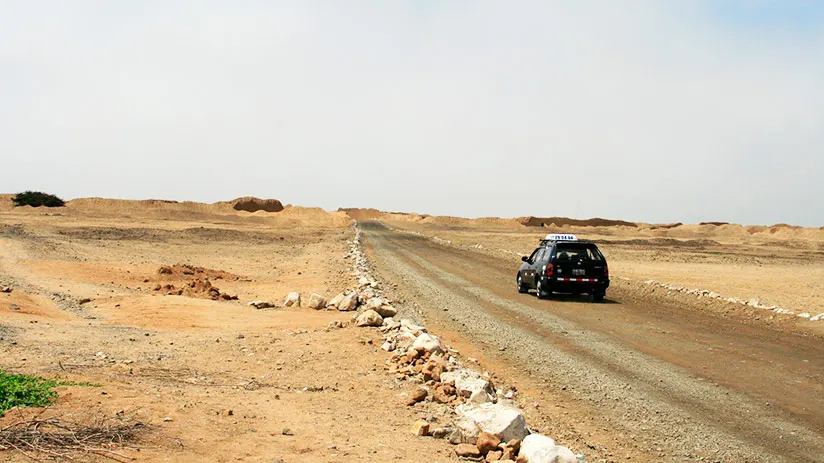
Once you arrive in Trujillo, you can tour the city or start your adventure immediately. To get to the city of Adobe, you can take a bus to Huanchaco. It is a beach in the north and the main tourist destination of Trujillo city. Of course, previously, you’ll have to indicate to the driver that you want to get off in Chan Chan parallel.
The bus ticket costs around $1 – $2, and the trip lasts 30 minutes. These buses leave you 1 km from the archaeological park. From this point, you can walk or take a taxi (there are many of them waiting for tourists) up to the archaeological park. The taxi costs around $2 more.
You can also take a taxi directly from Trujillo to the Mud City. The taxi service costs around $5 – $10, and the trip lasts 20 minutes.
Likewise, you can take a bus heading to Trujillo if you are in Huanchaco. And indicate to the driver to drop you up at the parallel archaeological park. The cost is the same $1 – $2. From this point, you will have the same option, walk or take a taxi to the wonder.
You can tour the citadel with a tourism agency or operator, depending on your Peru itinerary. These usually offer guided tours with a specialist tour guide every day.
Best time to visit it
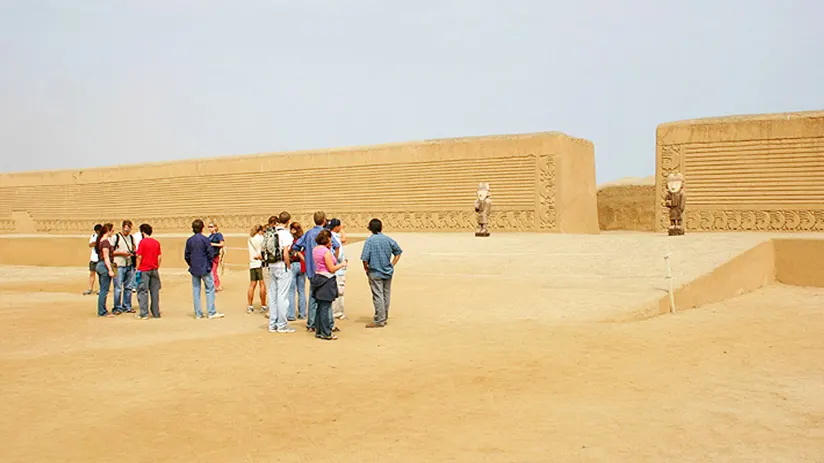
The best time to visit Peru will depend on the season. Generally, the west-north coast of Peru presents two well-defined seasons, the summer and the winter. The Peruvian coast in Summer (from November to April) presents high temperatures with gusts of wind and small sand storms.
There may even be heavy rains but of short duration. However, the influx of tourists will be short. If you want to visit the mud city in Summer, we recommend doing it in the early morning hours. This is important to avoid the hard sun, gusts of wind and enjoy fresh weather.
The winter on the Peruvian coast lasts from June to August and offers clear blue skies and fresh weather. However, the demand for tourists is high, so you’ll probably share the experience of visiting this wonder with many people. So, take precautions.
If you want our opinion, winter is the best time to visit the Chan Chan Archaeological site!
Entrances and Schedules
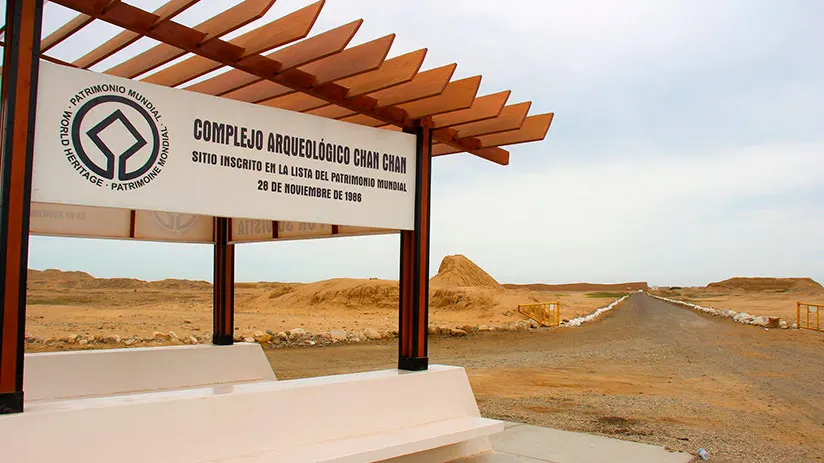
The archeological zone is open from Tuesday to Sunday. From 09:00 am – 16:00 pm.
- Adults: S/ 10 ($ 3)
- Children: S/ 5 ($ 1.5)
You can buy the tickets at the same entrance to mud-city or at the site museum. The entrance fee also grants you access to the Huaca Esmeralda and Huaca Arco Iris in Trujillo.
A tour guide for Chan Chan
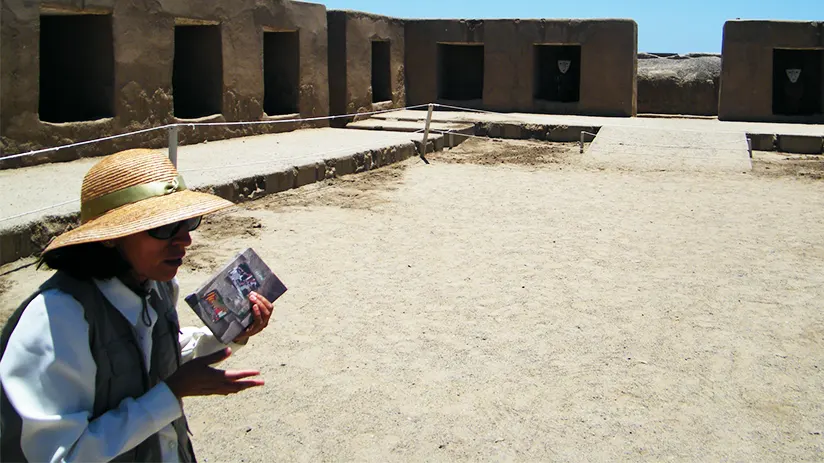
Knowing the ruin’s history makes visiting it more meaningful. Since the archaeological city doesn’t have information panels, we recommend hiring a local tour guide.
They are close to the city entrance and charge $10 per person. The guided visit will last 1 hour for a maximum of 5 participants. If you want, you can stay longer in the mud city after the tour.
If you want to do the tour independently, you can buy an information booklet at the ticket office for $0.50 or 2 Soles. Then, you only have to follow a marked trail inside the complex.
What to bring
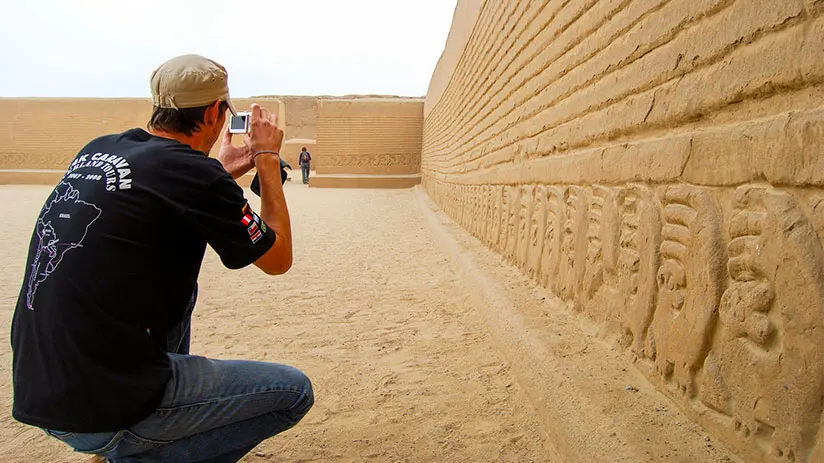
- Protect yourself from the sun by wearing a hat and sunscreen.
- Staying hydrated will help you enjoy your ride.
- If you choose to hire a travel agency, make sure that it has the corresponding authorization.
- It is important to carry nuts as snacks.
- If you are traveling with a minor, they must be under a responsible adult and protected from the sun’s rays.
- Don’t forget your documents.
“ARCHEOLOGY HOLDS ALL THE KEYS TO UNDERSTANDING WHO WE ARE AND WHERE WE COME FROM”
We hope that this information has been useful to you in learning a little about the Chan Chan archaeological zone. But we believe that a guided tour is the best way to enjoy this amazing archaeological complex.
A tour of the area can enlighten you about the different cultures that inhabited the area since the Incas were not the only ones who lived in Peru. We expect, together with Machu Travel Peru, to have been able to clarify all aspects regarding the wonderful city of mud.
If you plan to enjoy this incredible attraction, you can take advantage of other nearby destinations. Consult with our team of advisers to find out the best travel plan for you. Do not miss the wonderful opportunity to enjoy the Andean country.
Peru has so much to offer, it can be hard to know where to start. With many years of experience in the tourism sector, Machu Travel Peru is happy to help with anything regarding your trip to Machu Picchu and any tours around it. Make your Machu Picchu experience an unforgettable one!